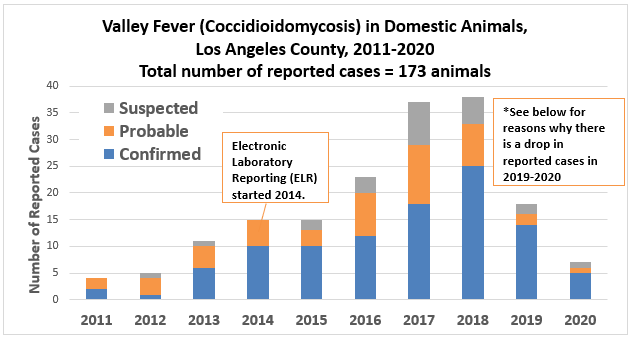Veterinary Public Health Program
313 N Figueroa St. Rm 1127
Los Angeles, CA 90012
Tel (213) 288-7060
Fax (213) 481-2375
vet@ph.lacounty.gov
|

Note: PDF documents on this site were created using Adobe Acrobat
5.0 or later. If you are using an earlier version of Adobe Acrobat
Reader (4.x or less), document functionality may be reduced.
|
|
|
Coccidioidomycosis (Valley Fever) in Animals in Los Angeles County
|
What is Coccidioidomycosis (Valley
Fever)?
It is an infection caused by a fungus called
Coccidioides. The fungus lives in dirt in
certain limited parts of the world. In Los Angeles County, the fungus is
most common in the San Fernando Valley and in high desert areas, such as the
Antelope Valley.
The fungus grows best in sandy, alkaline soils
in areas with hot summers and warm winters. When
the dirt is disturbed by digging or excavation,
the fungal spores are released as dust into the
air.
People and animals can become infected when they
inhale the spores into the lungs. Many
people and animals develop immunity to the
fungus and do not get sick, while other can
become very ill. The fungus does not
spread from person to person, or from animal to
animal.
What are the symptoms of Valley Fever in
animals?
Many types of animals can have Valley Fever, but
the most serious infections are usually seen in
dogs, cats and primates. The most common symptom
in dogs is coughing, but may also include low
appetite, limping, enlarged joints, fever and
possibly diarrhea. Cats get infected less often,
but may have skin problems (abscesses, draining
lesions), fever, low appetite, and weight loss.
How do you know if your pet has Valley
Fever?
Your veterinarian needs to perform tests to
confirm the disease. Many times a combination of
x-rays, blood tests, and sometimes biopsy are
needed to confirm infection.
What is the treatment for Valley Fever
in animals?
A veterinarian will prescribe antifungal
medications. In some cases, these medications
must be given to the animal for long periods of
time.
Are there any cases of Valley Fever in
animals in Los Angeles County?
Yes. In the decade between 2011 and 2020, a
total of 173 cases
of Valley Fever were reported in LA County
domestic
animals. In 41% of the cases, the animal had
most likely become infected while in Southern
California.

Can humans get Valley Fever?
Yes. Humans can get Valley Fever from the
environment.
Click here to read more about Valley Fever in
humans.
How can I protect my pet from Valley
Fever?
In areas where Valley Fever is more common,
avoid stirring up dirt or dust. Do not allow
your pet to dig. When you must dig in soil
yourself, use water to control dust. Keep your
pet indoors, with windows closed, during dust
storms.
Tracking Valley Fever in Animals in LA
County
Valley Fever in animals is reportable in Los
Angeles County. The reports help track trends in
this disease. In 2014, laboratories were
required to begin reporting cases, and the
reports available increased. Cases are
categorized as Confirmed, Probable, or Suspected
based on the
Coccidioidomycosis Case Definition for LA County.
Of the 173 cases reported between 2011-2020, 60%
were Confirmed, 27% were Probable, and 13% were
Suspected.

*Why is there a drop in reported cases
of Valley Fever in animals in Los Angeles County
in 2019 and 2020?
While it appears that there is a
significant decrease in reported Valley Fever
cases in animals in Los Angeles County in 2019
and 2020, the actual incidence of disease or
number of cases may not be fewer. A
laboratory that is required to report cases did
not report between late 2019 and all of 2020 and
this is largely responsible for the obvious drop
in reported cases. Additionally, the
COVID-19 pandemic may have had an impact on pets
being taken in for veterinary visits and pets
being tested for this disease.
Reporting Valley Fever Cases in Animals
VETERINARIANS: Report a case of
coccidioidomycosis by using
this form
 and email it in to
vet@ph.lacounty.gov or fax to 213-481-2375.
and email it in to
vet@ph.lacounty.gov or fax to 213-481-2375.
More information:
Valley Fever (Coccidioidomycosis) - Los Angeles County
Department of Public Health
|
|
Last updated: September 7, 2023 |
|
|